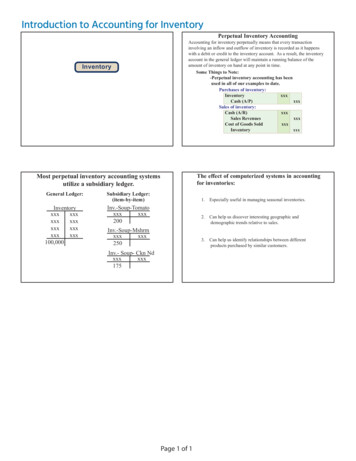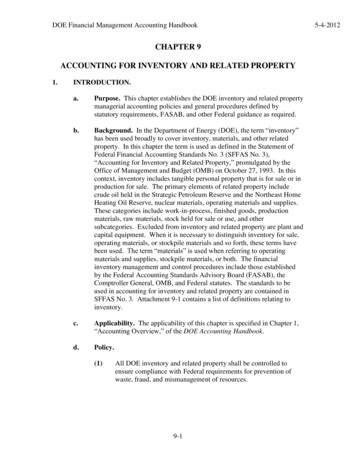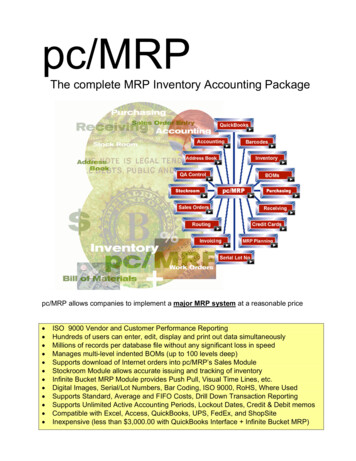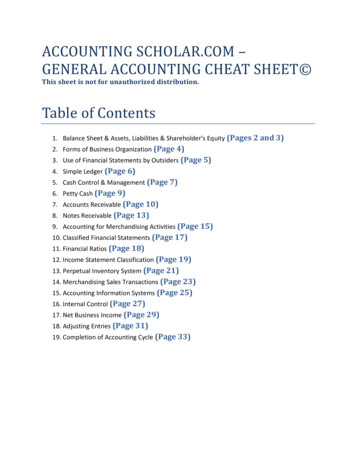
Transcription
Introduction to Accounting for InventoryInventoryMost perpetual inventory accounting systemsutilize a subsidiary ledger.General Ledger:Subsidiary xxxx100,000Inv.-Soup-Tomatoxxxxxx200Perpetual Inventory AccountingAccounting for inventory perpetually means that every transactioninvolving an inflow and outflow of inventory is recorded as it happenswith a debit or credit to the inventory account. As a result, the inventoryaccount in the general ledger will maintain a running balance of theamount of inventory on hand at any point in time.Some Things to Note:-Perpetual inventory accounting has beenused in all of our examples to date.Purchases of inventory:InventoryxxxCash (A/P)xxxSales of inventory:Cash (A/R)xxxSales RevenuesxxxxxxCost of Goods SoldInventoryxxxThe effect of computerized systems in accountingfor inventories:Inv.-Soup-Mshrmxxxxxx250Inv.- Soup- Ckn Ndxxxxxx175Page 1 of 11.Especially useful in managing seasonal inventories.2.Can help us discover interesting geographic anddemographic trends relative to sales.3.Can help us identify relationships between differentproducts purchased by similar customers.
Purchase Discounts and Returns of InventoryExamples of perpetual inventory accounting givencomplicating factors of purchase discounts and returns.On 11/1/X2, Joe's Bicycle Store buys as inventory 20 bicycles for 100 each,terms of 2/10, n/30. Two days later, Joe returns one defective bike to themanufacturer for credit on his account. On 11/9/X2, Joe pays the balancedue net of the discount.Entry at 11/1/X2 to record purchase on account:Inventory (20 x 100)2,000Accounts Payable2,000Entry at 11/3/X2 to record bicycle return:Accounts Payable100Inventory (1 x 100)The accounting for inventory perpetually requiresaccounting for the inflow and outflow of the # of unitsand any increases or decreases in the cost of those units.Original cost of the bicycles: (20 @ 100 each)True cost of the bicycles:(20 @ 98 each)True inventory balance:19 @ 98 each 1,862Inventory2,000100 Return of 1 unit10038 Discount of 2% x 1,900Entry at 11/9/X2 to payoff account, net of discount amouting to 38:1,900Accounts PayableCash ( 1,900 - 38) (98% x 1,900)1,862Inventory (2% x 1,900)381,862Problem: Purchase Discounts and ReturnsSolution: Purchase Discounts and ReturnsMercy Lawn Mower Shop had the following transactions duringthe first twelve days of March, 20X7:Mercy Lawn Mower Shop had the following transactionsduring the first twelve days of March, 20X7:March 1 Purchased 10 lawn mowers on account at 200 each,terms of 2/10, n/30.2 Returned 1 lawn mower to supplier because the framewas bent; received credit on account for 200.10 Paid supplier the net amount owed for the lawnmowers purchased on March 1, net of the discount.11 Sold 5 lawn mowers for 400 each for cash.12 One of the lawn mowers sold on March 11 wasreturned; cash was refunded.Journalize these transactions.Page 1 of 13/1 InventoryAccounts Payable3/2Accounts PayableInventory2,0002,0002002003/10 Accounts PayableCash (98% x 1800)Inventory (2% x 1800)1,8003/11CashSales RevenueCost of Goods SoldInventory(5 x 196 980)2,0003/12 Sales Returns and AllowancesCashInventoryCost of Goods Sold4001,764369801962,000980400196
Inventory Cost FlowsComplications in Accounting forInventory Cost FlowsNow, assume one car is sold to a customer for 7,000 cash.The entry would be:Example: Assume you are starting a used car business andbuy 3 cars for resale. If you buy an old VW Bug for 2,000, aclassic Camaro for 4,000, and an old souped-up Pinto for 6,000, the journal entries to record their purchase would 006,000CashSales RevenuesCost of Goods ,0006,000If Pinto:Cost of Goods SoldInventory6,000If VW Bug:Cost of Goods SoldInventory2,000Inventory20253075 20 25 30Assume your first customer comes by and buys 1lb. of jellybeans for 4.CashSales RevenuesCost of Goods SoldInventory?4?Would there have been any difference in the amount of cost of goodssold between the methods if all the inventory had been sold?LIFO 120FIFO 120AVE. 120(75) 45(75) 45(75) 452,000Last in first out (LIFO):Cost of Goods SoldInventory3First in first out (FIFO):Cost of Goods SoldInventory2Gross Margin/Profit(Revenues - Cost of Goods Sold) 5,00032Average cost ( 75 30 lbs. 2.50/lb.):Cost of Goods Sold2.50InventoryResult Comparison:Net Sales RevenueLess: Cost ofGoods SoldGross Margin4Gross Margin/Profit6,000 (Revenues - Cost of Goods Sold ) 1,000End InventorySales RevenueLess: Cost ofGoods SoldGross Margin7,000Perpetual Specific Identification MethodExample: Assume you want to start a business that sellsjelly beans. Your purchases of inventory are as follows:10 lbs. @ 2.00/lb.10 lbs. @ 2.50/lb.10 lbs. @ 3.00/lb.7,0002.50LIFO 4FIFO 4AVE. 4( 3) 1( 2) 2(2.50) 1.50 72 73 72.50What method would you use if you had not observed the actualphysical flow?Under GAAP you may use any method regardless of theactual physical outflow of inventory; however, the methodselected must be consistently used over time.What is the likely physical outflow of inventory at a supermarket?Page 1 of 2
Inventory Cost FlowsWhat method would you choose if it was your business?Net Sales RevenueLess: Cost ofGoods SoldGross MarginEnd. InventoryLIFO 4FIFO 4AVE. 4( 3) 1( 2) 2(2.50) 1.50 72 73 72.50What would be the effect of the different methods on netincome in a deflationary environment?10 lbs. @ 3.00/lb.10 lbs. @ 2.50/lb.10 lbs. @ 2.00/lb.Sales RevenuesLess: Cost ofGoods SoldGross MarginA. To impress investors?B. To pay less income tax?InventoryWhatever method you use for financial reporting toinvestors and creditors, you must also use for incometax reporting.a. i.ii.Prepare the journal entry to record the sale of the Mustang for 2,750cash on 1/29/X6Which cost flow method is appropriate under the circumstances?Why?(2)2(3)1(2.50)1.50 72 72.50 73Cash2,750Cashb.Sales RevenueCost of Goods SoldGross Marginc.Page 2 of 21,8502,750Sales RevenueCost of Goods SoldInventoryUsing the specific indentification inventory cost flow.Using a FIFO inventory cost flow assumption.c.AVE 4Sales RevenueCost of Goods SoldInventoryDate PurchasedCost1/6/X6 6501/19/X6 1,050On January 25, 20X6 he buys for cash a decent Ford Mustang for 1,850.Determine the gross margin on the Mustang sale under both costflow methods.FIFO 4Solution: Inventory Cost FlowsGremlinPintob.LIFO 4Deflationary times create the opposite result.Joe has a small used car business going. Hecurrently has the following in inventory:i.ii. 30 25 20What would be the results in a period of stable costs?Problem: Inventory Cost Flowsa. 6502,7501,8502,750650SpecificIdentificationFIFO 2,750(1,850) 900 2,750(650) 2,100Specific identification is appropriate in this case because of theunique nature of each inventory item.
Effects of Inflation and DeflationGraph of Inflation(Cost per unitof inventorypurchases)Last costs,most recentcosts, highercosts 6 4-JanFebMarCost ofGoods SoldHigherLowerLIFOFIFO 2-AprMayNet FebMarAprCost ofGoods SoldLowerHigherLIFOFIFO1. Which inventory cost flowmethod would produce thehighest tax liability in a periodof deflation, assuming not allinventory was sold?First costs,older costs,higher costs 6-Last costs, most recentcosts, lower costs 4-Using these graphs, respond to the following questions:(Cost per unitof inventorypurchases)First costs,older costs,higher costs 6-First costs,older costs,lower costs 2-Graph of Deflation(Cost per unitof inventorypurchases)MayNet IncomeHigherLowerTaxesHigherLower(Cost per unitof inventorypurchases) 6-leftover 4-Last costs, most recentcosts, lower costsJanLIFOFebMarCost ofGoods SoldLowerAprMayNet IncomeHigherJuneTaxesHigher 2-JanFirst costs,older costs,lower costs(Units Sold)Feb Mar AprFIFOsoldFebMarAprMayFIFOJune(Time)Problem: LIFO vs. FIFO EffectsLast costs,most recentcosts, highercosts(Ending Inventory) 4- 2-Jan(Time)3. Which inventory cost flow method results in endinginventory that utilizes the most recent costs? 6-(Time)2. Which inventory cost flow method would result in thehighest ending inventory balance in a period of inflation? 4 2-JuneChoose between FIFO, LIFO and the Weighted Average inventory costflow assumptions used on a perpetual basis to respond to the followingquestions: (Assume under all scenarios that there is a balance of inventoryon hand at the end of the period)a.Which method would produce the highest net income in inflationarytimes?b.Which method would produce the highest income tax in deflationarytimes?c.Which method would produce the highest ending inventory balance ininflationary times?d.Which method would produce the lowest ending inventory balance indeflationary times?MayJunee.Which method would produce the highest net income in a period ofstable prices?(Time)f.Which method would produce the highest net income in inflationarytimes assuming there is no balance of inventory at the end of the period?Page 1 of 2
Effects of Inflation and DeflationSolution: LIFO vs. FIFO Effectsa.b.c.d.e.f.FIFOLIFOFIFOFIFOSame under all methodsSame under all methodsPage 2 of 2
Application of FIFO, LIFO, MWAPractical Application of FIFO, LIFO, and MovingWeighted Average Inventory Cost Flow Assumptionsa.FIFO:Cost of Goods SoldBeginning Inventory5/5 Purchase5/7 Sale5/13 Purchase5/19 Sale5/23 Purchase5/29 SaleCostper Case 20 21# of Cases1,0003004004005006005008,00010,000 22 2310,5005/13 400 @ 22 8,80030010,000 500 @ 205/23 600 @ 23 13,800100 @ 20300 @ 2110,500 100 @ 22400 UnitsSold5/7500 UnitsSold5/19500 UnitsSold5/2920,400c. Moving Weighted Average:b.LIFO:Cost of Goods SoldCost of Goods SoldInventory5/5 300 @ 21 6,3008,3005/13 400 @ 22 8,80010,8005/23 600 @ 23 13,80010011,500300 @ 218,300 100 @ 20400 @ 2210,800 100 @ 2011,500 500 @ 2330,6005/13 400 @ 22 8,800500 CasesSoldMWA:900 @ 20.23400 @ 221,3005/19500 CasesSold5/2910,3855/23 600 @ 23 13,800MWA:800 @ 20.77 16,616600 @ 23 13,80030,4161,40030,416 / 1,400 21.73per unit10,863 500 @ 21.73 5/29Ending Inventory: 900 x 21.73 19, 560Rounded 18,207 8,80027,00727,007 1,300 20.77per unit10,385 500 @ 20.77 5/19Problem: FIFO, LIFO, MWAInventory19,5608,092 400 @ 20.23 5/78,0925/7(Continued)10,863MWA:26,300 1,300 20.23per unit400 CasesSold18,300Cost of Goods SoldInventory5/1 1,000 @ 20 20,0005/5 300 @ 21 6,3005/1 1,000 @ 20 20,00090080029,3408,000 400 @ 2028,500Calculate the amount of Cost of Goods Sold for the month of May andthe balance of ending Inventory at 5/31 under a. FIFO, b. LIFO, and c.Moving Weighted Average inventory cost flows assumptions.(Continued)Inventory5/1 1,000 @ 20 20,0006001005/5 300 @ 21 6,300Example: Jimbo’s is a wholesale distributor of hot dogs. The followingreflects Jimbo's inventory transactions for May, 20X1:Young, Inc. imports leather purses from Korea and sells them to retailers in theUnited States. The inventory flows and related costs for a particular purse styleduring the month of January, 20X1 is noted below:Cost# of Unitsper UnitBeginning Inventory500 121/3 Purchase200 131/7 Sale2501/11 Purchase400 141/17 Purchase300 151/22 Sale3501/25 Purchase200 151/28 Sale220If these purses sell to retailers for 30/ea., determine the amount of 1/31/X1inventory and January's cost of goods sold, gross margin and % markup oncost under the following cost flow assumptions.a.b.c.Page 1 of 2Perpetual FIFOPerpetual LIFOMoving Weighted Average
Application of FIFO, LIFO, MWASolution: FIFO, LIFO, MWASolution: FIFO, LIFO, MWAa. FIFOInventoryCost of Goods Sold 3,0004,3001/1 (500 x 12) 6,0002501/3 (200 x 13) 2,6001001/1 (400 x 14) 5,6002801/17 (300 x 15) 4,5001/25 (200 x 15)3,0002,980 10,280a. FIFO 3,000 (250 x 12) 1/7Gross margin:(250 x 12)4,300 (100 x 13) 1/22Net sales revenue (820 x 30) 24,600(10,280)Less: Cost of goods sold 14,320% Markup on cost: 14,320 10,280 1.39 or 139%(100 x 13)2,980 (120 x 14) 1/28Debits - Credits 11,420Solution: FIFO, LIFO, MWAb. LIFOCost of Goods Sold 3,2005,2003,280Solution: FIFO, LIFO, MWAInventory1/1(500 x 12) 6,0004501/3(200 x 13)2,6001/11 (400 x 14)3503305,6001/17 (300 x 15)4,5001/25 (200 x 15)3,000b. LIFO (continued)3,200 ( 2 0 0 x 1 3 ) 1/7250 Units( 50 x 12) soldGross margin:Net sales revenueLess: Cost of goods sold(300 x 15)5,200 ( 50 x 14) 1/12350 Unitssold3,280 ( 2 0 0 x 1 5 )( 20 x 14) 1/28% Markup on cost: 12,920 11,680 1.11 or 111%220 Unitssold 10,020 11,680 24,600(11,680) 12,920Solution: FIFO, LIFO, MWASolution: FIFO, LIFO, MWAc. Moving Weighted AverageCost of Goods SoldInventory1/11/3MWA:(500 x 12) 6,000(200 x 13)2,600 8,600 700 12.293,071c. Moving Weight ed Averag e:3,0711/111/17MWA:(250 x 12.29)5,600(400 x 14)4,500(300 x 15)450 x 12.29 5,529400 x 14 5,600300 x 15 4,50015,6291,1501/7Gr oss margin : 15,629 1,150 13.594,7571/25(200 x 15)3,000MWA:800 x 13.59 10,872200 x 15 3,0001,0004,7571/1213,872 13,872 1,000 13.873,05210,880(350 x 13.59)3,052(220 x 13.87)1/2810,820Page 2 of 2Net sales reve nu eLess: Cost of goods sold 24,600(10,880) 13,720%% Ma r ku p on cost: 13,720 10,880 1.261 or 126
Physical Inventory Count and RecapWhat is a physical inventory?Why is a periodic physical inventory necessary ifyou maintain a perpetual subsidiary ledger forinventory?Page 1 of 1Pilferage ExpenseInventoryXXXXXX
6,000, the journal entries to record their purchase would be: 2,000 4,000 6,000 12,000 Inventory Inventory Cash Inventory Cash Inventory Cash 2,000 4,000 6,000 2,000 4,000 6,000 Now, assume one car is sold to a customer for 7,000 cash. The entry would











